The Invisible Trainer – How to Build an Automated Coaching Business

Teaching is one of the oldest professions on planet earth.
If you take a look at the top 5 professions that dominate the human race, it would be agriculture, health & medical care, construction, cloth making and Training.
Since the olden days we’ve had Gurus where young people went to learn from them.
In every profession of work, there is a mentor and a student.
Out of the 5 professions I told you about, every profession involves teaching.
Transferring skills from an experienced person to an unskilled person is the very fabric of the human race that keeps us together.
Before we invented written language and printed books, knowledge and experience was transferred from one generation to another using stories.
During the tribal times where groups of 100-500 people lived in forests, the elders of the tribe would tell stories to the younger generation and they would pass on moral values.
Then there were people who hunted, gathered, people who grew crops, people who did carpentry and people who built huts. In every category, the expert will teach the novice.
People realized that sometimes you have to pass on information which transcends time. The trainer cannot always be present in flesh and blood and hence they started painting inside cave walls.
For example, someone would have painted how to make a spear, that can be used to hunt down animals. This blueprint could be used to by anyone, even by people in the next generation 100 years later to make a spear.
Eventually, language and communication skills evolved and people invented writing. But even with writing, you cannot replicate it. People used to write on stones and papyrus.

Right now, you can buy a 12″ x 16″ papyrus on Amazon as a collectible.
But ancient people used to transfer their knowledge and experience on Papyrus and it was very important in the human evolution.
According to UniverseToday.com,
The Homo group: including our own species, Homo sapiens – began arising more than two million years ago, the museum said. It’s distinguished by bigger brains, more tool-making and the ability to reach far beyond Africa. Our species was distinguished about 200,000 years ago and managed to survive and thrive despite climate change at the time. While we started in temperate climates, about 60,000 to 80,000 years ago the first humans began straying outside of the continent in which our species was born.
Let’s say we are 200,000 years old as a distinguished species.
The printing press was invented by Gutenberg in the 14th century.

“In 1455 Gutenberg completed his 42-line Bible, known as the Gutenberg Bible. About 180 copies were printed, most on paper and some on vellum.” – Wikipedia.
This was in the first time in the history of mankind, the concept of content replication came into existence.
Until then, there was only one copy of every written material ever.
Imagine that this article I am writing, is available on one physical written copy!
How bad would it be!
I would be lucky to get 100 readers over a period of a week, if I manually distribute it to people and then take it back to give it to the next.
And this was just 5 centuries ago.
Considering that we have been here for at least 200 centuries, the evolution of content happened in the last 97% of our time on earth.
The printing press was able to replicate content on scale.
For the first time, the same content, can be read by multiple people, at the same time, across time and distance. And this was a huge leap for Content!
And look at how far we have come in the past 500 years.
The first computers and electronic displays came in the 18th century. That came like in the last 1% of our time on earth.
The internet is even more recent.
If you are just reading this blog post right now on your device, at your own comfort within your home or office, be totally excited.
We are living at the cutting edge of human technological evolution.
For the first time ever, one can write an article, hit publish on a WordPress blog and if all the billions of internet users want to read it the next minute, they can!
And this type of content replication power is great for education and training.
With the increase in access to devices and internet in the past 10 years, we can also communicate via videos and photos apart from text.
And the content transfer from one person to another has become as close as a trainer sitting next to you and teaching you something.
Which brings me to the purpose of this article…
The Invisible Trainer.
If you want to be a trainer online, it is not as simple as writing a blog article and publishing it.
But once you learn how to replicate yourself, at almost no cost, to 1000s of students, and be as efficient as sitting next to them, you will find that you have landed on a very profitable career.
I have been training students on Blogging and Digital Marketing and over the past few years I have discovered that there is a good way and a bad way to do it.
The easiest way to create content is to write blog posts and publish YouTube videos, but that doesn’t make you a trainer.
A lot of people do that, but they do not know how to monetize the audience’s attention in the best way possible. And they end up relying on display ads like Google Adsense which pays very little for every view or click.
So let’s go over the various steps involved in becoming an Invisible Trainer. If you follow these steps, you will be able to literally Teach and Grow Rich.
1. Branding
For any student to learn from a trainer, he/she should first look up to the trainer. And the students should know that a trainer exists.
If you are planning to become a trainer online, the first thing that you should work on is your brand positioning. What do you want to be known as?
There are going to be many trainers in the market, and you need to differentiate yourself.
I have positioned myself as a digital marketing and blogging expert and this has been my focus for a long time. As I keep having the focus on this niche, it becomes stronger over time.
That’s why I went our of my way to acquire domain names like…
- www.LearnBlogging.com
- www.LearnDigitalMarketing.com
- www.BloggingTools.com
- www.DigitalMarketingClub.com
And I invested all my savings into these names long back.
People look for indicators of authority and expertise.
Some of the indicators include:
Being an author of a book which has sold a good number of copies. And the book should have good ratings. I’ve done that with one of my books on Amazon
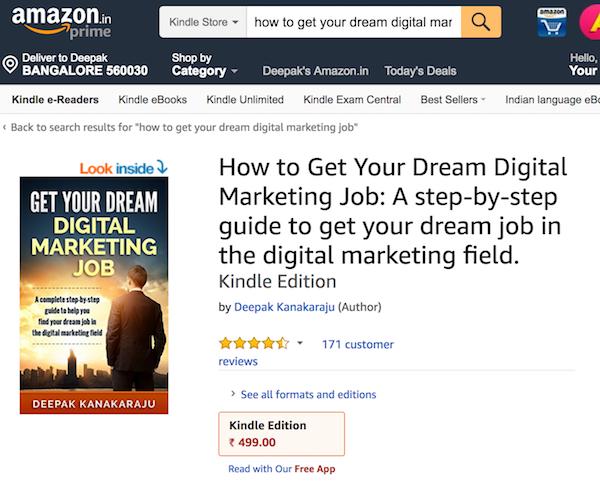
Being a public speaker helps a lot in authority. I have done a TEDx talk and this talk has more than 100,000 views.
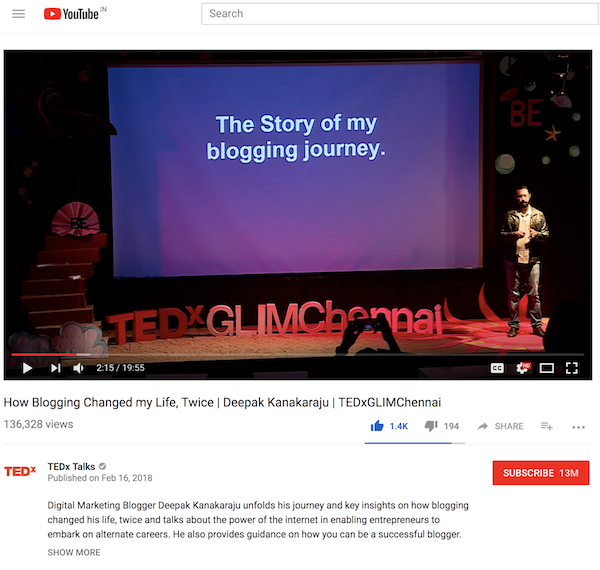
Have a good number of followers on Social Media channels also helps a lot in authority. My Facebook page has 250,000+ followers.
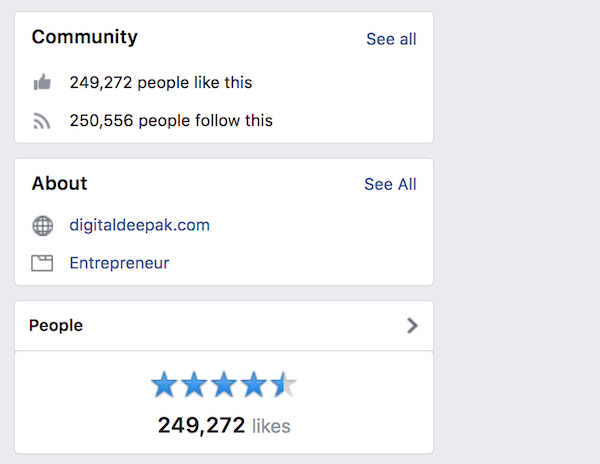
Branding has 3 major components to it…
a. Brand Awareness (Reach)
The first is the reach of the brand.
Being a book author, being a public speaker, speaking at events done by other brands, doing interviews with other experts in the same niche and so on will help with the reach of the brand.
Brand awareness is important.
That’s why Facebook has a separate ad type for brand awareness. They also give metrics for brand recall. Which takes us to the next point…
b. Brand Recall (Engagement and Frequency)
And the brand becomes a more familiar brand for people when the frequency is higher. People will forget about the brand if it is shown to them once. Deeper brand engagement with higher frequency is what makes a strong brand over time.
If you are reading this line right now, you have spent at least 5 minutes reading this article to come up to this point. That’s deep brand engagement. And if you have read 10 articles on my blog before this, then this is the 11th time you are reading… that’s frequency.
So my brand “Digital Deepak” is becoming stronger, because it is getting a higher mind space with you than other bloggers.

Frequency to some extent can be measured using Google Analytics. Here you can see that I have 1000+ people who have visited my blog for the 5th time in the past 30 days.
My best customers are going to come from this segment. Many people have visited my blog only once in the past 30 days and that’s OK. Not everyone will come back for more content all the time.
When you are starting out the reach of the brand will be low.
But make sure that you have a higher engagement and frequency with your audience even if it is just 1,000 subscribers or followers.
c. Brand Perception (Positioning and Authority)
The way your followers perceive your personal brand is very important for them to become your students in the future.
Your followers should see you as a successful person and they would want that kind of success for themselves. That’s when they will be motivated to become your students.
If you are reading this right now, there is a good chance that you want to become a successful blogger and trainer. Else why would you be reading from me right now?
And as discussed above, indicators of authority like being an author and a public speaker gives a good brand perception among the audience.
Sharing your perspectives and what you believe also gives you a cult status as a personal brand.
There are many trainers who have built a cult status within their market and they have a strong tribe of people who follow them and learn from them.
Positioning also involves whether you can position yourself as a premium brand and be perceived as the best in the market.
Now let’s look at the most important flowchart of this article… (click on the image to expand it in a new tab).
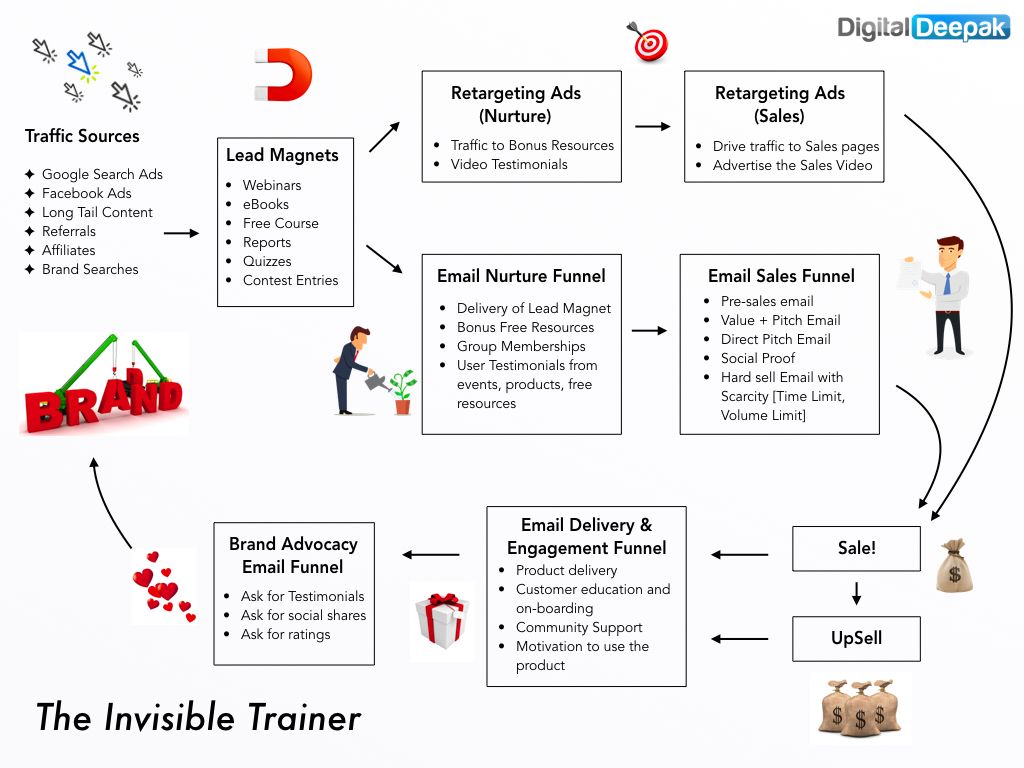
In this flowchart, you can see that branding comes last.
But in this article, I talked about branding first.
That’s because, the whole point of creating a marketing funnel is to build a strong brand with maximum reach, engagement, frequency and perception.
If I am being perceived as the best digital marketing trainer in India, I wouldn’t need to do any marketing activity. I will just get sales, because I will become the go to person.
Think about Google. They don’t need to advertise they are a search engine anymore. Everyone knows them, and everyone knows that they are the best search engine around. So now one uses any other search engine. Google doesn’t NEED marketing at all.
That’s the goal of every brand… to build the brand using marketing, but to get to a point where marketing is not needed.
But until you become a well known, well perceived brand, you need to do marketing. And the way we can do it is what the above flowchart is about.
For a personal training brand like me, it might take forever to be perceived as the best digital marketing trainer. So a Google like brand is just an ideal scenario and not a practical scenario.
But it helps to think like that because that’s the direction we should be taking. And eventually the trainer can become someone like Tony Robbins one day. Or may be not. But the path and the direction should be clear.
2. Lead Generation
To have good brand engagement and frequency, it is important to generate leads. Without lead generation, we cannot reach out to the potential customers again. Retargeting is one method, but leads help us get a deeper brand engagement.
As you can see from this flowchart, the traffic sources give brand awareness, but it also gives leads. Google ads, Facebook Ads, Content etc. helps with brand awareness to start with. But with the traffic that is attracted, we can convert them into subscribers using lead magnets.
A lead magnet converts a visitor into a subscriber by giving an ethical bribe. Here are the lead magnets that can be used by people in the training industry:
- Webinar registrations
- eBooks
- Free Course delivered via Email
- Reports
- Quizzes
- Contest entries
All the above lead magnets quality a visitor into a potential buyer.
Traffic to these lead magnets can be driven via Facebook Ads, Google Ads and via content on the blog.
The major way that I drive traffic to lead magnets is via Facebook Ads. I’ve spent more than $55,000 on Facebook Ads until now and have generated 100s of thousands of leads.
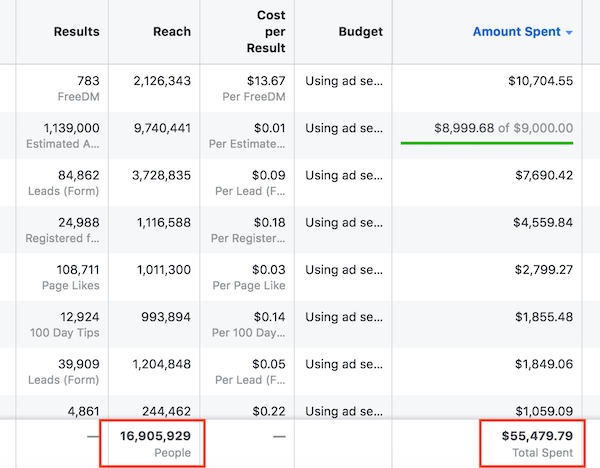
I also use an exit popup on my blog so that visitors to my blog come via the search engines can have an opportunity to optin.

This exit popup is shown only to the people who are browsing my website on desktop. In the most recent campaign, it has generated 1252 leads for me at 8.92% conversion rate.
So for every 100 visitors to my blog on desktop, I am able to convert 9 people into subscribers for my Free Digital marketing course (that’s the lead magnet).

Now that we can discussed on a few different methods to generated leads (subscribers), what to do next?
If you have the email IDs, can you send a offer to purchase your training course to these people directly? NO!
That’s like a door-to-door sales man presenting a product for a purchase directly.
New subscribers do not know the trainer and there needs to be an opportunity to build brand engagement and frequency. That’s where we get to the next point in this article…
3. Nurturing
Nurturing is the process where brand engagement and frequency happens. You, as a trainer, shouldn’t ask for the sale in the beginning.
Instead, deliver free content and valuable stuff for your leads / subscribers for free. That’s what I do with my subscribers for almost a month.
I add them to my drip marketing campaign, which delivers value via email over a period of time.
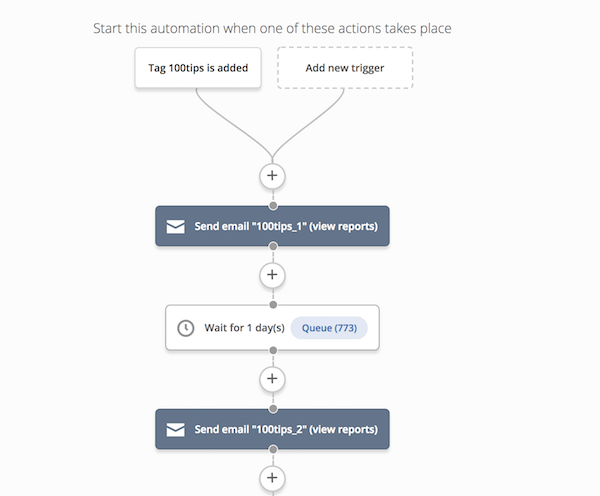
I am using ActiveCampaign for my drip marketing and I deliver content via emails over a period of time. The above screenshot shows one such automation that I have setup with ActiveCampaign.
In the nurturing sequence, I am increasing the brand engagement and frequency.
Generating leads and delivering content through email is the best method for engagement. But I can also retarget my subscribers (or even visitors to the landing page) with ads. I can run campaigns on Facebook that is shown only to previous visitors and subscribers. This also increases the engagement.

In this flowchart, you can see that nurture happens parallel via Ads and Email.
Once the nurture sequence is done, we have good engagement, frequency – which leads to good brand perception and brand recall.
Now the subscribers are ready to convert into students of your online course.
But they will not convert as soon as you present the product to them. You need to remove their objections that is preventing them from converting into a paid student.
That leads to the next point…
4. The Sales Sequence
You can pitch your online training program to anyone who has expressed interest in learning a specific topic. The sales page is the main asset in making a sale online.
You can check out a few of my sales pages for my products:
I drive traffic to these pages using retargeting ads, but the ads are run only for the people who have already engagement with my content.
If new people come to this page, it doesn’t convert well. It makes sense to send new visitors to a lead magnet, nurture them, increase brand engagement, frequency and perception and then present the product.
Apart from retargeting ads, the traffic is also driven via email. In fact, the email sales sequence is the best converting channel for converting existing leads into buyers.
The sales email sequence is triggered when someone clicks on the landing page (which shows that they are interested) and doesn’t purchase immediately.
The sales sequence will contain emails in the following topics:
- Reasons why this course is for them
- Testimonials from existing customers
- What they will get from the completion of the course
- How the course is delivered (structure and resources)
- The learning community
- Scarcity or urgency (like limited slots available and last day to enroll).
With such a sales sequence, prospects will convert into paying customers (in this case, students of your course).
The sales sequence leads to the sale, and you can also upsell other products to the same audience if they are ready for a higher commitment.
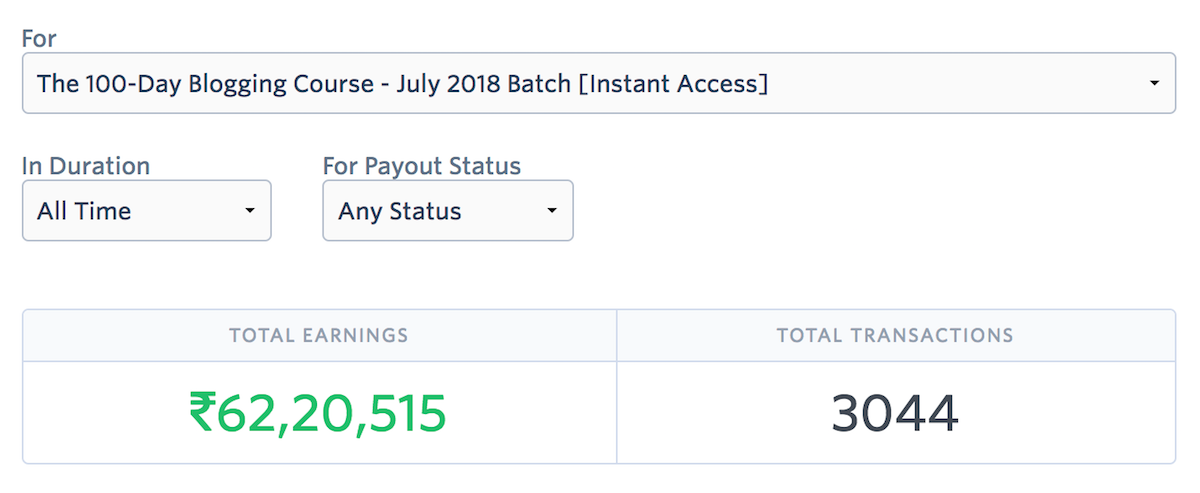
I’ve used this automated sales method to sell the blogging course to more than 3,000 customers and it has brought in more than 62 Lakhs+ in revenue.
And I am not even including the other courses that have been up-sold to the people who have bought the 100-day blogging course.
5. Delivery
If you want to be a truly invisible trainer, then you have to setup the delivery of your products. I collect payments using the Instamojo payment gateway and connect it to my email marketing account using Zapier.
As soon as the purchase happens, the access to the online coaching is sent via email.
I use Teachable for hosting my online courses. It has an inbuilt international payment gateway, but it doesn’t have good options for payments from India. So I use Instamojo payment gateway as an alternative solution and connect the two.
Teachable connects to my domain’s subdomain using CNAME records and I have hosted the LMS at learn.digitaldeepak.com
This is how the LMS looks with all the lessons hosted in it…

And if you open a specific course, the lessons are laid out like this…
Every lesson can be marked as complete once the student finishes the lesson.

There are many learning management solutions available in the market.
I use Teachable. Podia and Thinkific are also good alternative options for online trainers.
6. Brand Advocacy
After the course delivery, and after a certain period of time where I am sure that the student has consumed at least 30% of the course material, I ask for feedback.
Along with feedback, I also ask for ratings and testimonials.
Apart from asking feedback for specific courses, I also ask my audience to give ratings on my Google My Business and Facebook Page. This automation has given me ratings like these…

Reviews from existing customers is very powerful for converting new customers and it strengthens the brand image. Here’s where the brand perception is improved!
And with brand advocacy, we are completing the flowchart.
Automate Everything
You can see that in the above 6 steps, everything is automated.
I have paid campaigns that are running everyday.
Retargeting campaigns for content and sales running everyday.
Email marketing for both nurturing and sales keeps happening.
Sales keep happening.
Delivery keeps happening.
Reviews and brand strengthening also keeps happening.
The only area where I might not be able to automate is support. I have a dedicated member of the team working on support tickets and it is usually related to payments and access.
Most of my courses are very affordable and self serve courses. At such price point, I can’t give individual attention to each student’s questions. And students also understand that because they know the pricing of the courses is very affordable.
If I charge higher for the courses, I can enroll less students and I would be able to give my personal attention to each student, but that defeats the whole idea of being an invisible trainer!
I hope this article helped you understand how to become an invisible trainer.
Stay tuned for more content related to this method. And if you have any questions, leave it on the comments!
Cheers,
Deepak Kanakaraju